Experimental Investigation and Analysis of Bond–Slip Behavior between Geopolymer Concrete and Steel Tube with Varying Structural Measures
Abstract
1. Introduction
2. Test Details
2.1. Material Properties
2.2. Experimental Design
2.3. Measuring Point Arrangement and Loading Scheme
3. Test Results and Analysis
3.1. Test Phenomena
3.2. Load–Slip Curves
3.3. Load–Strain Curves
3.4. Bond Strength–Slip Curve
4. Bond–Slip Constitutive Relation
4.1. Establishment of Bond–Slip Constitutive Relation
4.2. Calculation of Shear Bearing Capacity of Shear Structural Measures
4.2.1. Structural Specimens with Steel Studs
4.2.2. Structural Specimens with Steel Studs
5. Conclusions
Author Contributions
Funding
Data Availability Statement
Conflicts of Interest
References
- Pacheco-Torgal, F.; Castro-Gomes, J.; Jalali, S. Alkali-activated binders: A review: Part 1. Historical background, terminology, reaction mechanisms and hydration products. J. Constr. Build. Mater. 2008, 22, 1305–1314. [Google Scholar] [CrossRef]
- Kaliyavaradhan, S.K.; Ling, T.C. Potential of CO2 sequestration through construction and demolition (C&D) waste-An overview. J. CO2 Util. 2017, 20, 234–242. [Google Scholar] [CrossRef]
- Xuan, D.; Zhan, B.; Poon, C.S.; Zheng, W. Carbon dioxide sequestration of concrete slurry waste and its valorisation in construction products. J. Constr. Build. Mater. 2016, 113, 664–672. [Google Scholar] [CrossRef]
- Han, L. Concrete Filled Steel Tube Structure—Theory and Practice; Science Press: Beijing, China, 2016. [Google Scholar]
- Han, L.-H.; Li, W.; Bjorhovde, R. Developments and advanced applications of concrete-filled steel tubular (CFST) structures: Members. J. Constr. Steel Res. 2014, 100, 211–228. [Google Scholar] [CrossRef]
- Chen, L.; Dai, J.; Jin, Q.; Chen, L.; Liu, X. Refining bond-slip constitutive relationship between checkered steel tube and concrete. J. Constr. Build. Mater. 2015, 79, 153–164. [Google Scholar] [CrossRef]
- Robinson, M.J.; Melby, I.H. Effects of bonding in short-span rectangular concrete filled GFRP tubes. Compos. Struct. 2015, 133, 131–139. [Google Scholar] [CrossRef]
- Qu, X.; Chen, Z.; Nethercot, D.A.; Gardner, L.; Theofanous, M. Load-reversed push-out tests on rectangular CFST columns. J. Constr. Steel Res. 2013, 81, 35–43. [Google Scholar] [CrossRef]
- Kilpatrick, A.E.; Rangan, B.V. Influence of interfacial shear transfer on behavior of concrete-filled steel tubular columns. ACI Struct. J. 1999, 96, 642–648. [Google Scholar] [CrossRef]
- Zhao, H.; Li, J.; Wang, R.; Lam, D.; Zhang, Y. Study on interfacial bond behavior of recycled aggregate concrete filled stainless steel tubes (RAC-FSST). J. Constr. Build. Mater. 2021, 313, 125532. [Google Scholar] [CrossRef]
- Lyu, W.Q.; Han, L.H. Investigation on bond strength between recycled aggregate concrete (RAC) and steel tube in RAC-filled steel tubes. J. Constr. Steel Res. 2019, 155, 438–459. [Google Scholar] [CrossRef]
- Song, T.-Y.; Wang, C.-H.; Liu, X.-L.; Xiang, K.; Zhou, H. Post-fire bond behaviour in elliptical concrete filled steel tubes: Experiment and simulation. J. Constr. Steel Res. 2023, 201, 107725. [Google Scholar] [CrossRef]
- Campione, G.; Mindess, S.; Scibilia, N.; Zingone, G. Strength of hollow circular steel sections filled with fibre-reinforced concrete. Can. J. Civ. Eng. 2000, 27, 364–372. [Google Scholar] [CrossRef]
- Roeder, C.W.; Cameron, B.; Brown, C.B. Composite action in concrete filled tubes. J. Struct. Eng. 1999, 125, 477–484. [Google Scholar] [CrossRef]
- Hunaiti, Y.M. Composite action of foamed and lightweight aggregate concrete. J. Mater. Civil. Eng. 1996, 8, 111–113. [Google Scholar] [CrossRef]
- Yasser, H.; Minoru, W.; Kiyoshi, M. Experimental evaluation of the effect of bond on the maximum capacity of composite columns. J. Constr. Steel Res. 1992, 22, 39–55. [Google Scholar] [CrossRef]
- Tao, Z.; Han, L.-H.; Uy, B.; Chen, X. Post-fire bond between the steel tube and concrete in concrete-filled steel tubular columns. J. Constr. Steel Res. 2011, 67, 484–496. [Google Scholar] [CrossRef]
- Tao, Z.; Song, T.-Y.; Uy, B.; Han, L.-H. Bond behavior in concrete-filled steel tubes. J. Constr. Steel Res. 2016, 120, 81–93. [Google Scholar] [CrossRef]
- An, L.; Cederwall, K. Push-out tests on studs in high strength and normal strength concrete. J. Constr. Steel Res. 1996, 36, 15–29. [Google Scholar] [CrossRef]
- Shim, C.-S.; Lee, P.-G.; Yoon, T.-Y. Static behavior of large stud shear connectors. J. Eng. Struct. 2004, 26, 1853–1860. [Google Scholar] [CrossRef]
- Okada, J.; Yoda, T.; Lebet, J.P. A study of the grouped arrangements of stud connectors on shear strength behavior. Struct. Eng. Earthq. Eng. 2006, 23, 75–89. [Google Scholar] [CrossRef]
- Qiao, Q.; Zhang, W.; Qian, Z.; Cao, W.; Liu, W. Experimental study on mechanical behavior of shear connectors of square concrete filled steel tube. J. Appl. Sci. 2017, 7, 818. [Google Scholar] [CrossRef]
- Dong, H.; Chen, X.; Cao, W.; Zhao, Y. Bond-slip behavior of large high-strength concrete-filled circular steel tubes with different constructions. J. Constr. Steel Res. 2020, 167, 105951. [Google Scholar] [CrossRef]
- GB/T 2975-2018; Sampling Position and Sample Preparation for the Mechanical Properties Test of Steel and Steel Products. China Standards Press: Beijing, China, 2018.
- GB/T 228.1-2010; Method of Room Temperature Tensile Test of Metal Materials. China Standards Press: Beijing, China, 2010.
- Guan, M.; Lai, Z.; Xiao, Q.; Du, H.; Zhang, K. Bond behavior of concrete-filled steel tube columns using manufactured sand (MS-CFT). J. Eng. Struct. 2019, 187, 199–208. [Google Scholar] [CrossRef]
- Lv, J.; Zhou, T.; Du, Q.; Li, K.; Jin, L. Research on the bond behavior of preplaced aggregate concrete-filled steel tube columns. J. Mater. 2020, 13, 300. [Google Scholar] [CrossRef] [PubMed]
- Zhang, N.; Ju, T.; Qiu, R. Experimental study on the bond-slip behavior of steel tube-coal gangue concrete. Int. J. Press. Vessel. Pip. 2024, 209, 105209. [Google Scholar] [CrossRef]
- GB 50917-2013; Design Code of Steel-Concrete Composite Bridge. China Standards Press: Beijing, China, 2013.


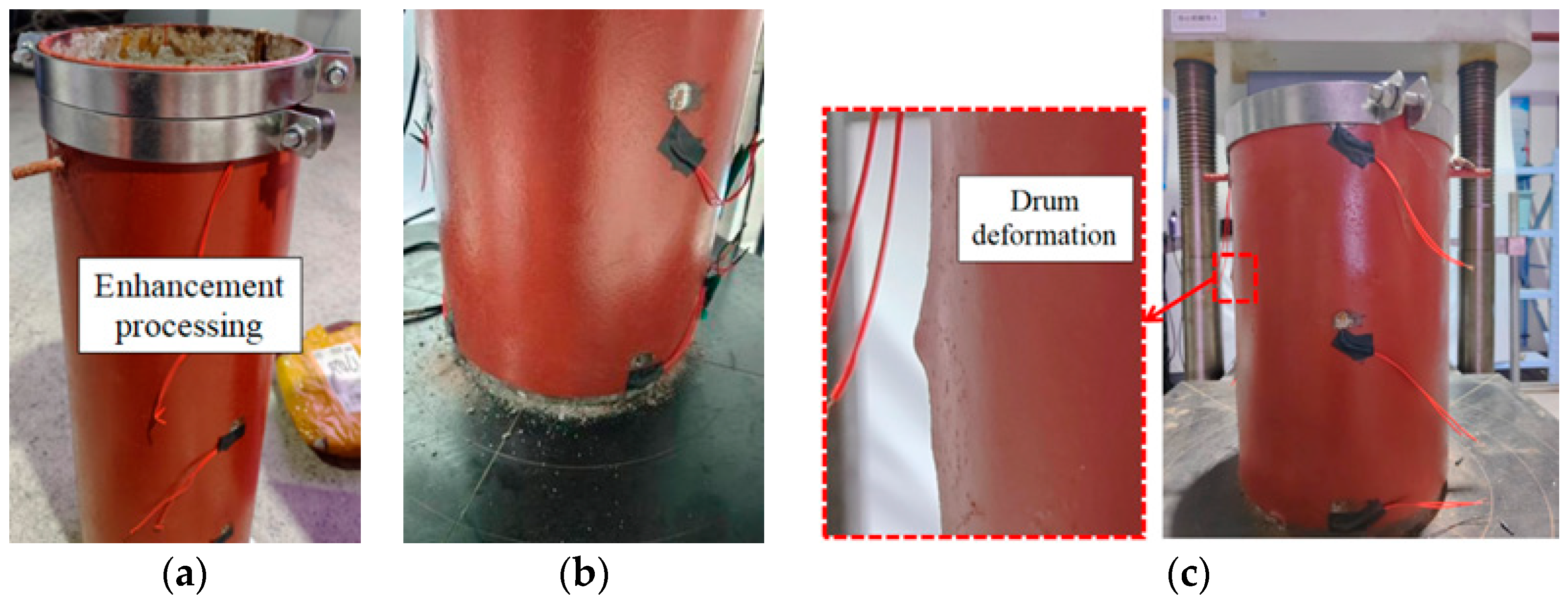
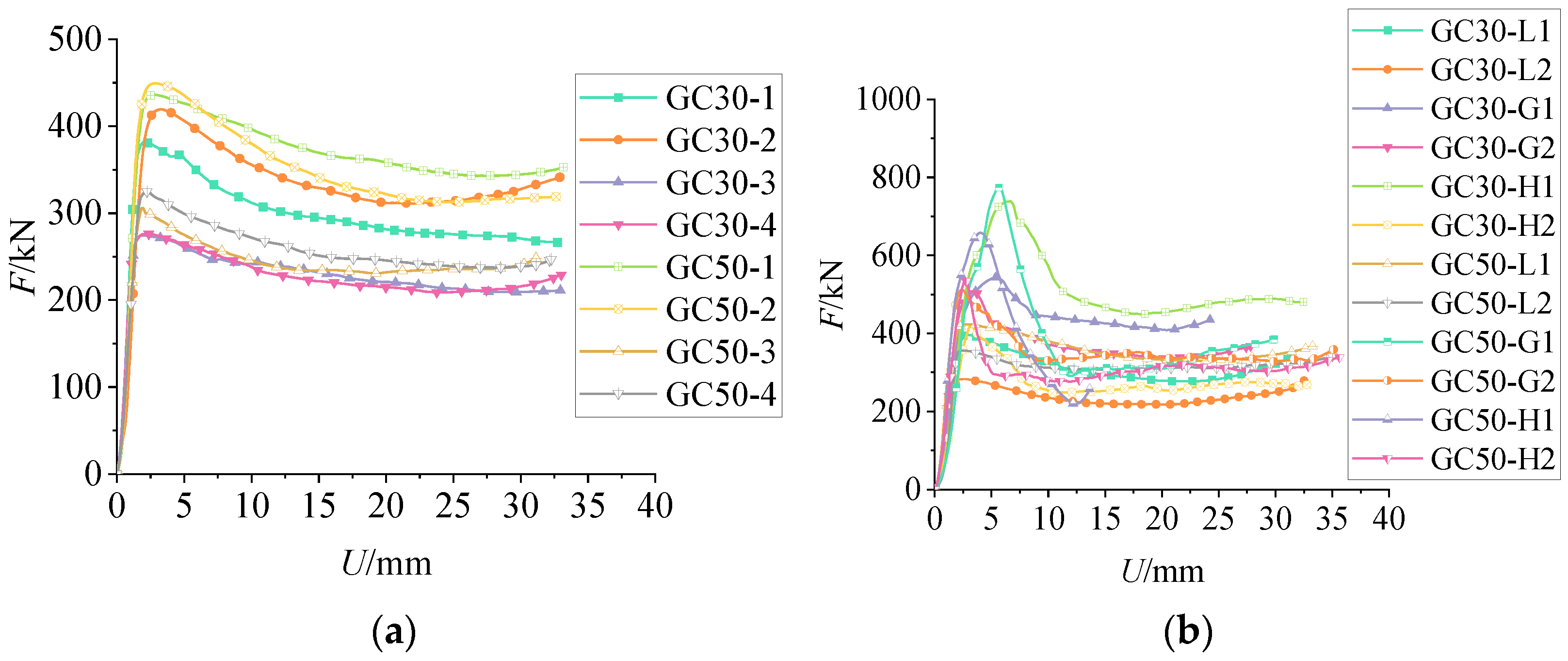

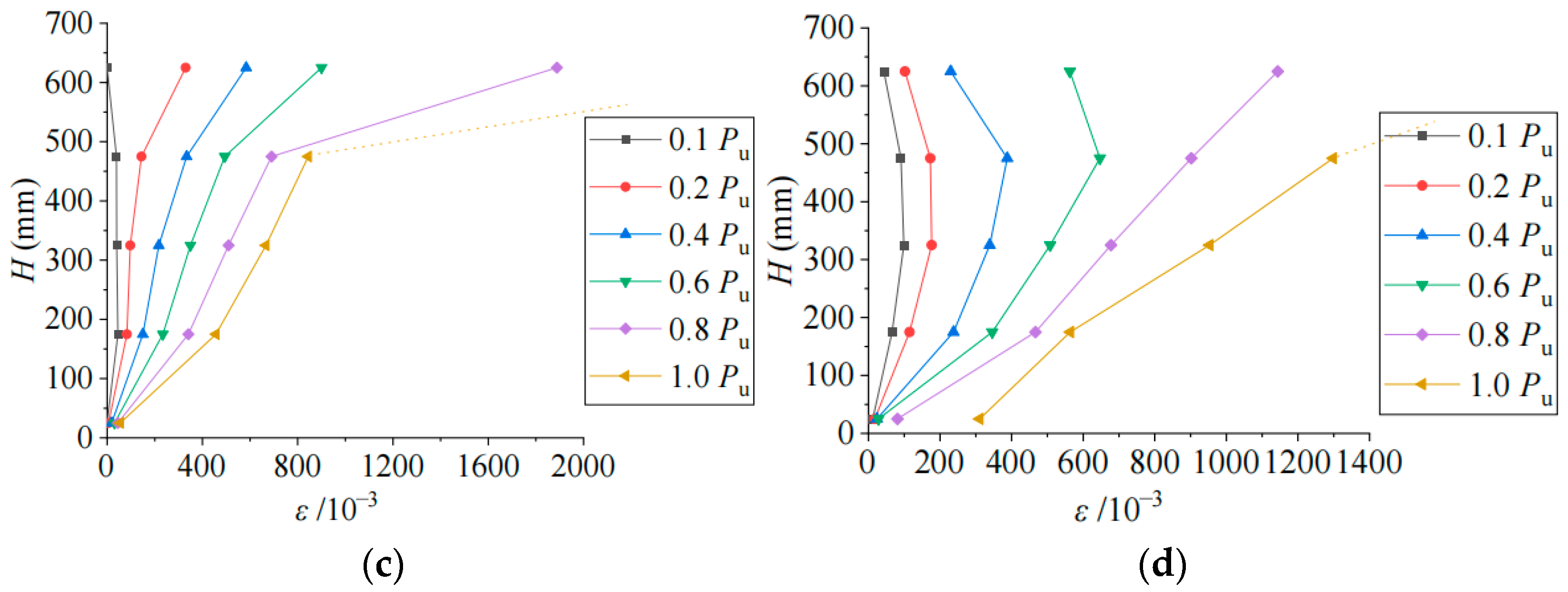
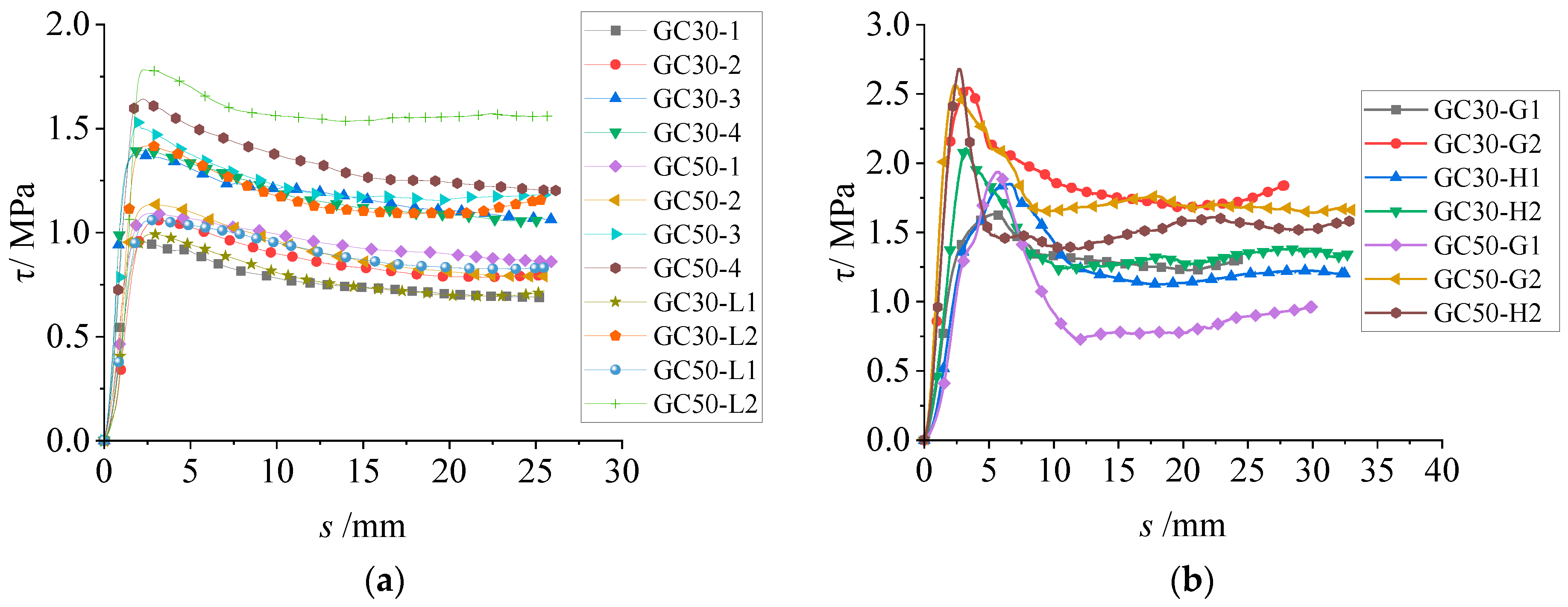
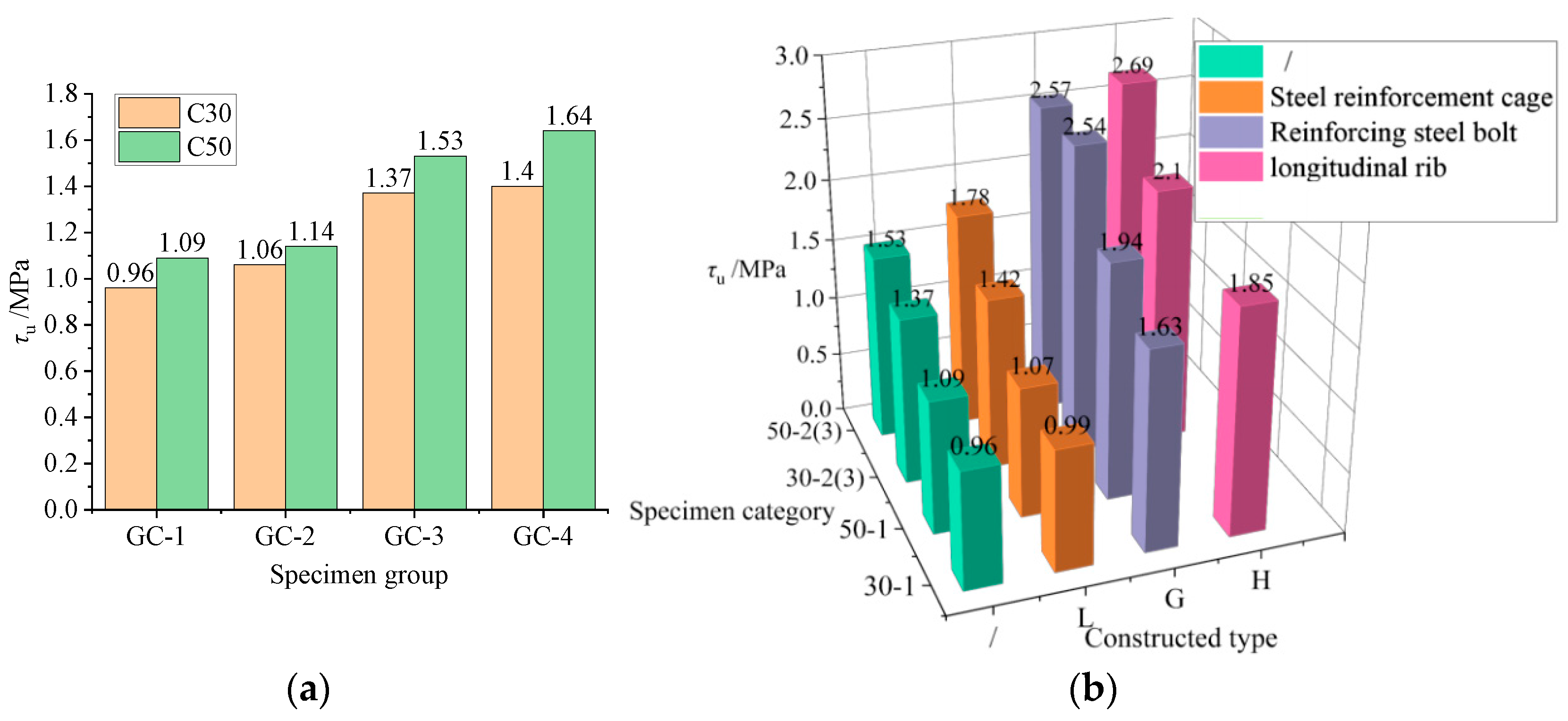
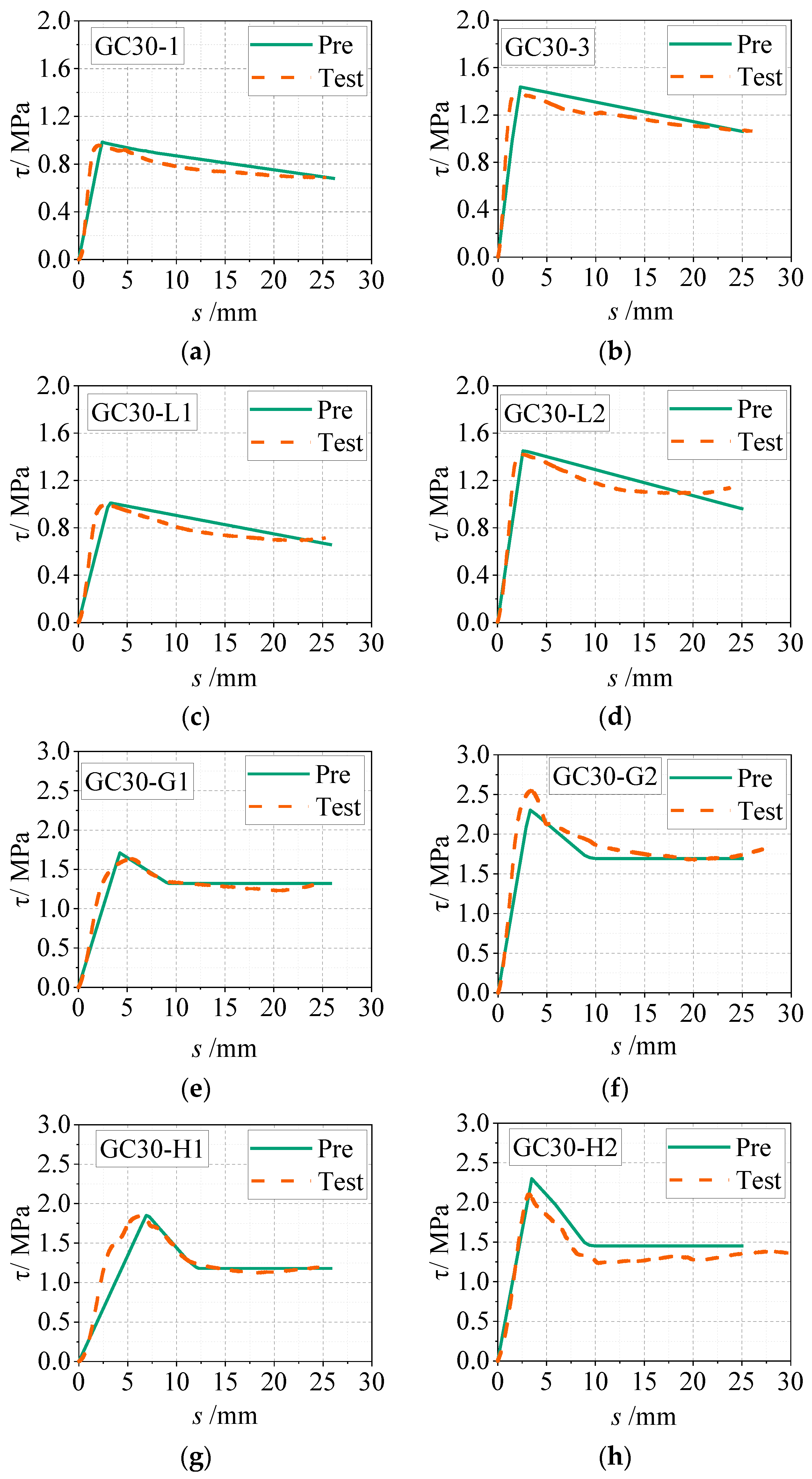
| Materials | Thickness (Diameter)/mm | Yield Strength/MPa | Ultimate Strength/MPa | Elongation/% | Elastic Modulus/MPa |
|---|---|---|---|---|---|
| Steel tube | 3.5 | 294.51 | 354.51 | 18.67 | 2.11 × 105 |
| Steel tube | 4.5 | 300.31 | 364.67 | 26.13 | 2.12 × 105 |
| Circular rib | 4.0 | 367.89 | 509.26 | 21.64 | 2.01 × 105 |
| Stud | 8.0 | 471.55 | 679.86 | 19.87 | 2.04 × 105 |
| Concrete Type | Fly Ash | Metakaolinite | Water Glass | NaOH | Water | Sand | Pebble | Industrial White Sugar | Water-Reducing Admixture |
|---|---|---|---|---|---|---|---|---|---|
| GC30 | 207 | 207 | 181 | 42 | 77 | 536 | 1250 | 26 | 10 |
| GC50 | 194 | 194 | 226 | 52 | 45 | 537 | 1252 | 25 | 10 |
| Specimens | Strength Grade | D × t × L (mm) | L/D | D/t | Pu/kN | su/mm | Structural Measures |
|---|---|---|---|---|---|---|---|
| GC30-1 | C30 | 219 × 650 × 3.5 | 2.97 | 62.6 | 382.13 | 2.03 | |
| GC30-2 | C30 | 219 × 650 × 4.5 | 2.97 | 48.7 | 419.59 | 3.28 | |
| GC30-3 | C30 | 219 × 350 × 3.5 | 1.60 | 62.6 | 274.54 | 2.03 | |
| GC30-4 | C30 | 219 × 350 × 4.5 | 1.60 | 62.6 | 276.26 | 2.29 | |
| GC30-L1 | C30 | 219 × 650 × 3.5 | 2.97 | 62.6 | 396.58 | 2.86 | Steel bar cage |
| GC30-G1 | C30 | 219 × 650 × 3.5 | 2.97 | 62.6 | 643.37 | 3.86 | Stud |
| GC30-H1 | C30 | 219 × 650 × 3.5 | 2.97 | 62.6 | 739.27 | 6.64 | Ring rib |
| GC30-L2 | C30 | 219 × 350 × 3.5 | 1.60 | 62.6 | 284.24 | 2.28 | Steel bar cage |
| GC30-G2 | C30 | 219 × 350 × 3.5 | 1.60 | 62.6 | 508.46 | 3.34 | Stud |
| GC30-H2 | C30 | 219 × 350 × 3.5 | 1.60 | 62.6 | 420.24 | 3.19 | Ring rib |
| GC50-1 | C50 | 219 × 650 × 3.5 | 2.97 | 62.6 | 436.46 | 1.14 | |
| GC50-2 | C30 | 219 × 650 × 4.5 | 2.97 | 48.7 | 449.38 | 1.12 | |
| GC50-3 | C50 | 219 × 350 × 3.5 | 1.60 | 62.6 | 306.12 | 1.60 | |
| GC50-4 | C30 | 219 × 350 × 4.5 | 1.60 | 62.6 | 324.93 | 1.67 | |
| GC50-L1 | C50 | 219 × 650 × 3.5 | 2.97 | 62.6 | 426.81 | 1.16 | Steel bar cage |
| GC50-G1 | C50 | 219 × 650 × 3.5 | 2.97 | 62.6 | 773.86 | 5.67 | Stud |
| GC50-H1 | C50 | 219 × 650 × 3.5 | 2.97 | 62.6 | / | / | Ring rib |
| GC50-L2 | C50 | 219 × 350 × 3.5 | 1.60 | 62.6 | 356.19 | 1.71 | Steel bar cage |
| GC50-G2 | C50 | 219 × 350 × 3.5 | 1.60 | 62.6 | 513.79 | 2.38 | Stud |
| GC50-H2 | C50 | 219 × 350 × 3.5 | 1.60 | 62.6 | 538.24 | 2.71 | Ring rib |
| Specimens | Pu/kN | Pu,c/kN | τu/MPa | τu,c/MPa | τu/τu,c |
|---|---|---|---|---|---|
| GC30-1 | 382.13 | 390.09 | 0.96 | 0.98 | 0.980 |
| GC30-2 | 419.59 | 415.63 | 1.06 | 1.05 | 1.010 |
| GC30-3 | 274.54 | 288.57 | 1.37 | 1.44 | 0.951 |
| GC30-4 | 276.26 | 297.97 | 1.40 | 1.51 | 0.927 |
| GC30-L1 | 396.58 | 420.62 | 0.99 | 1.05 | 0.943 |
| GC30-L2 | 284.24 | 292.25 | 1.42 | 1.46 | 0.973 |
| GC30-G1 | 643.37 | 674.95 | 1.63 | 1.71 | 0.953 |
| GC30-H1 | 739.27 | 747.26 | 1.85 | 1.87 | 0.989 |
| GC30-G2 | 508.46 | 464.42 | 2.54 | 2.32 | 1.095 |
| GC30-H2 | 420.24 | 458.26 | 2.10 | 2.29 | 0.917 |
| GC50-1 | 436.46 | 456.48 | 1.09 | 1.14 | 0.956 |
| GC50-2 | 449.38 | 465.15 | 1.14 | 1.18 | 0.966 |
| GC50-3 | 306.12 | 320.13 | 1.53 | 1.60 | 0.956 |
| GC50-4 | 324.93 | 330.87 | 1.64 | 1.67 | 0.982 |
| GC50-L1 | 426.81 | 446.75 | 1.07 | 1.12 | 0.955 |
| GC50-L2 | 356.19 | 342.18 | 1.78 | 1.71 | 1.041 |
| GC50-G1 | 773.86 | 829.71 | 1.94 | 2.08 | 0.933 |
| GC50-G2 | 513.79 | 505.79 | 2.57 | 2.53 | 1.016 |
| GC50-H2 | 538.24 | 490.22 | 2.69 | 2.45 | 1.098 |
| Mean value | 0.982 | ||||
| Standard deviation | 0.050 | ||||
| Coefficient of variation | 0.051 |
Disclaimer/Publisher’s Note: The statements, opinions and data contained in all publications are solely those of the individual author(s) and contributor(s) and not of MDPI and/or the editor(s). MDPI and/or the editor(s) disclaim responsibility for any injury to people or property resulting from any ideas, methods, instructions or products referred to in the content. |
© 2024 by the authors. Licensee MDPI, Basel, Switzerland. This article is an open access article distributed under the terms and conditions of the Creative Commons Attribution (CC BY) license (https://creativecommons.org/licenses/by/4.0/).
Share and Cite
Li, D.; Wu, C.; Song, H.; Li, L.; Lv, G.; Yang, F. Experimental Investigation and Analysis of Bond–Slip Behavior between Geopolymer Concrete and Steel Tube with Varying Structural Measures. Buildings 2024, 14, 2516. https://doi.org/10.3390/buildings14082516
Li D, Wu C, Song H, Li L, Lv G, Yang F. Experimental Investigation and Analysis of Bond–Slip Behavior between Geopolymer Concrete and Steel Tube with Varying Structural Measures. Buildings. 2024; 14(8):2516. https://doi.org/10.3390/buildings14082516
Chicago/Turabian StyleLi, Dandan, Cuilian Wu, Hang Song, Linchang Li, Guanru Lv, and Fei Yang. 2024. "Experimental Investigation and Analysis of Bond–Slip Behavior between Geopolymer Concrete and Steel Tube with Varying Structural Measures" Buildings 14, no. 8: 2516. https://doi.org/10.3390/buildings14082516
APA StyleLi, D., Wu, C., Song, H., Li, L., Lv, G., & Yang, F. (2024). Experimental Investigation and Analysis of Bond–Slip Behavior between Geopolymer Concrete and Steel Tube with Varying Structural Measures. Buildings, 14(8), 2516. https://doi.org/10.3390/buildings14082516





